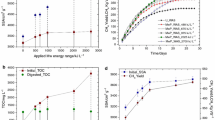Abstract
The Plackett-Burman saturated factorial design was used to select optimized dissolution conditions for sewage sludge samples. Three different digestion methods were applied: i) microwave oven digestion in a domestic oven with Parr-type reactors; ii) microwave oven digestion with controlled-pressure reactors; iii) pressure bomb reactor heated on a hot plate. The three methods were validated by statistically comparing the metal contents found with the certified ones of the sewage sludge sample (BCR 145R). No significant differences were obtained and the RSD values were lower than 3% in all cases. The metals were determined by flame-AAS. The variables studied were the following: microwave power; digestion time; predigestion; volume of hydrochloric acid; volume of hydrofluoric acid; volume of nitric acid. The operative advantages offered by microwave digestion with controlled-pressure reactors were also considered.
Similar content being viewed by others
Author information
Authors and Affiliations
Additional information
Received: 23 July 1997 / Revised: 31 October 1997 / Accepted: 5 November 1997
Rights and permissions
About this article
Cite this article
Lavilla, I., Pérez-Cid, B. & Bendicho, C. Optimization of digestion methods for sewage sludge using the Plackett-Burman saturated design. Fresenius J Anal Chem 361, 164–167 (1998). https://doi.org/10.1007/s002160050855
Issue Date:
DOI: https://doi.org/10.1007/s002160050855




